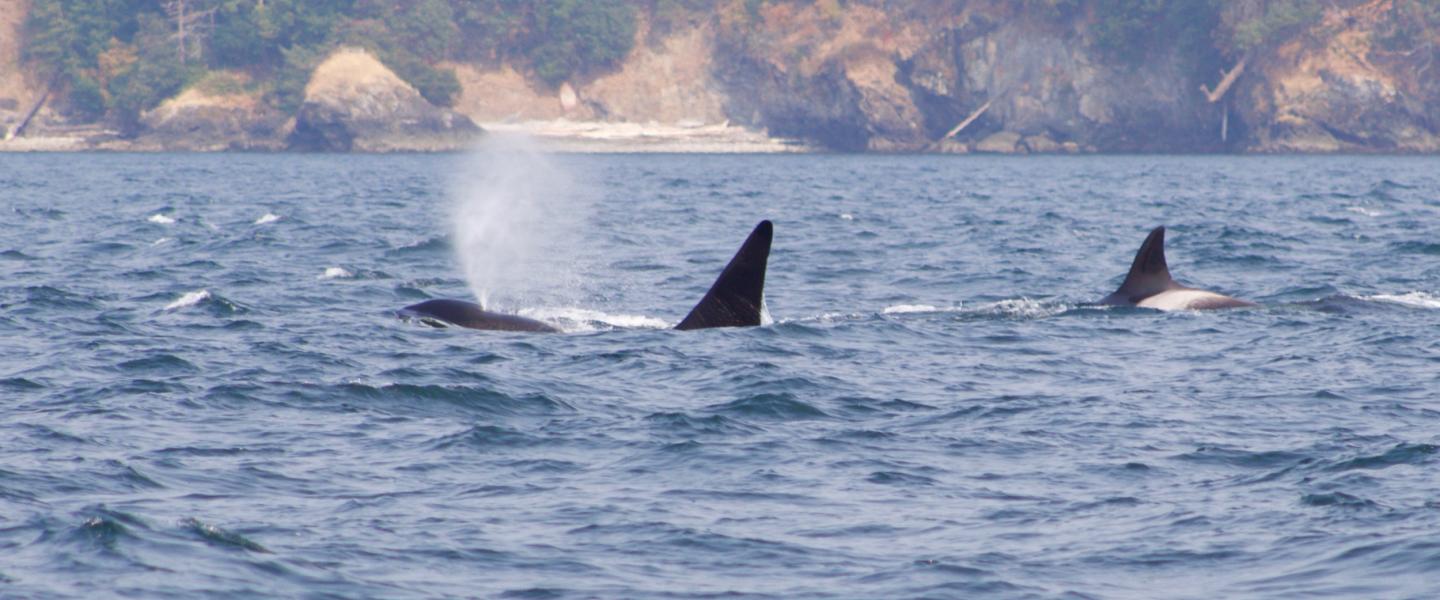
[Naturalist Erick D., M/V Kestrel, 8/9/17, 2:00PM]
On our afternoon trip for the day, Gabe and I and all the lovely folks aboard started another exciting search for some cool marine wildlife. Our first stop was one of our favorites. We motored down to Whale Rocks. These two Islets emerge from the waves of Cattle Pass just southwest of Lopez Island. You can see them from the shores of both Lopez and San Juan, and when they are covered by our favorite pinnipeds you can definitely hear the islands. These two rocks are glacially scraped so they look like two dorsal fins atop two giant Humpback Whales frozen forever midway through a surfacing. Wherever glaciers have passed over hard volcanic rock you’re apt to find rocks that look like these two, but these two have an extra special spot in my heart.
We approached closer to the rocks after checking out two Bald Eagles perched on top of nearby Deadman Rock. And we could quickly hear the current occupants. There a lot of Harbor Seals resting on the lower parts of these rocks all year, but in the summer months it is just them. All the other pinnipeds that we usually see here throughout the year go to various other places to mate and don’t return until the fall. This year though it’s looking a lot like fall is coming early in many different ways. The best way though are the Steller Sea Lions! These large behemoths are the largest species of sea lion in the world and they only exist in the North Pacific! They growl like large bears as one crawls over all the rest to get to his favorite napping spot. It’s always one of my highlights to watch these sea lions’ antics. We might see some more California Sea Lions again this year too as fall approaches, but none so far.
Next we headed north into Haro Strait along the west side of San Juan Island and soon saw some Orcas in between Kelp Reef and Kellett Bluffs on Henry Island. It was the same matriline/family that we saw earlier this morning – T18/T19’s! In the span of half a day they had traveled from west of Victoria all the way to northern San Juan Island, a distance of more than 20 miles! Orcas are one of the fastest mammals in the oceans and can go more than 30 knots if they want but even just traveling at a normal speed they often cover 100 nautical miles within 24 hours. We watched this family travel along San Juan Island’s western coast. They had eaten the first time we saw them and this Transient Orca family along with a few others that we often see in the inland sea area are specialist. They know all the best places to sneak up on seals, sea lions, porpoises, and other prey and they spend their time here bouncing between these places quietly hunting. This family of all adult orcas was on the hunt once more. Transient (Bigg’s) Orcas are often quieter than most other ecotypes of orcas because their prey are quite intelligent marine mammals themselves and the orcas don’t want to alert them to their presence.
After we left this super cool orca family once again we took one final stop next to Spieden Island. Spieden Island is a privately owned island. One of its previous owners opened an exotic hunting ranch here and when he left he left many of those animals behind. There are three exotic species left: Mouflon Sheep, Fallow Deer, and Sika Deer. This day we saw a bunch of the Mouflon Sheep and the Fallow Deer whose males are almost one growing their large antlers in preparation for the autumn.
Just when we were about to leave we saw an adorable family of River Otters! I know we’re in the Salish Sea and most folks would say Sea Otters (Enhydra lutris), but there are no Sea Otters permanently within the Islands, but there are many River Otters (Lontra canadensis) that swim and hunt in the salt water. These Otters swam from Sentinel Island to Spieden Island and started cleaning themselves after landing. Otters live in aquatic and marine environments, but they don’t have the same blubber layers that pinnipeds and whale species have so they have to keep their fur super clean and oily so that it keeps them as warm and dry as possible.
Whale folks, that’s the end of another San Juanderful Day here.
Until next time,
Naturalist Erick